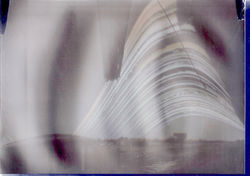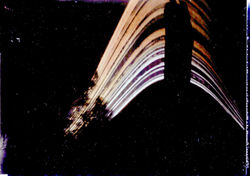
Nightwise.org
Solargraphs
A solargraph is a long-duration image of the sun's path captured from solstice to solstice by a simple pinhole camera. It is made from an aluminum can containing black-and-white photographic paper, as described at Anniversary Solargraph. Light that enters a tiny pinhole creates a diffuse image of the foreground buildings and landscape, while tracing a bright path of the sun through the months.

Top: Solargraph of Building 84, as observed from Union Station, South Bend, IN, from June to December solstices in 2016.
Bottom: Panoramic image of Building 84 taken with a cell phone camera from Union Station, South Bend, IN.
For stories about solargraphs, see blog posts tagged solargraph.
Try a solar eclipse version of a solargraph using SunPrint paper.
Or go with the black and white photographic paper. I know at least two other people made solargraphs of the 2017 eclipse. See images by Mauricio Gerra and by Don Hladiuk.

Images
 solg inside can-7288 |  sundial-2020Dec-adj |
|---|---|
 hosehouse3-adj |  hosehouse2-adj-feature |
 sol-balcony2-paired |  sol-rhoa-blow-bottom-adj-crop |
 sol-NBbeach-NEpost-paired-v1 |  sol-fiddlers-3 copy |
 la casa fence-adj |  la casa rooftop-adj |
 la casa fence-paired |  civil-rights-heritage-center-north-adj2. |
 aloft-paired.png |  colfax cultural center-paired.png |
 sundial-adj.jpeg |  can-oak hill June 2019.jpeg |
 IMG_9962.jpeg |  IMG_9649.jpeg |
 IMG_9661.jpeg |  IMG_9660.jpeg |
 IMG_9929.jpeg |  can-NB-top-2019June-edited.jpeg |
 IMG_9933.jpeg |  IMG_9930.jpeg |
 can-NB-bottom-2019June-edited.jpeg |  IMG_2164.jpg |
 IMG_2327.JPG |  sunprint-over-pano-copyrightBueter1024.jpg |
 spx-can-photo-compared 1.png |  Can-Rocco's pole-processed.jpeg |
 Can-copsh-lightbase-processed.jpeg |  Can-Bldg 84-2017june-processed.jpeg |
 Can-four-winds-2017june-processed.jpeg |  Can-SPX-PEC-stack-top-processed.jpeg |
 Can-ashville-patio-processed.jpeg |  Can-solar-panel1-processed.jpeg |
 Can-solar-panel2-processed.jpeg |  can-spindle-rotate-fliphoriz-coloradj.jpeg |
 outdoor-elements-solargraph.png |  boxes_8339.JPG |
 IMG_7763.jpg |  IMG_7361.jpg |
 IMG_7364.jpg |  IMG_7157.jpg |
 IMG_7167.jpg |  IMG_7188.jpg |
 copsh-anthony_6947.jpg |  copsh-second-mount_6949.jpg |
 copsh-house-arrow_6956.jpeg |  ashville-janet_6912.jpg |
 ashville-janet_6909.jpg |  inovateus-maurico-office_3807.jpg |
 can-Gensic-corrected1.png |  stpat-redbarn_6814.jpg |
 fourwinds-rooftop-south_6834.jpg |  fourwinds-homeplate-roofview-pan-winter_6767.jpg |
 solargraph_6716.jpg |  IMG_4851.jpg |
 can-jms-rob_2006.jpg |  cans-JMS-mounted_5448.jpg |
 cans-JMS-dismounted_5518.jpg |  can-JMS-edited.jpeg |
 can-JMS-can2-edited.jpeg |  can-unionstation-ted-train_0685.jpg |
 can-uinionstation-pan_0690.jpg |  unionstation-vertical-flipped-coloradjust.jpeg |
 unionstation-horiz-flipped-coloradjust.jpeg |  IMG_0276.jpg |
 can-copsh-kristie_1983.jpg |  IMG_0275.jpg |
 copsh-pan-GOPR1330.jpg |  can-copsh-flagpole-flipped-coloradjusted.jpeg |
 can-copsh-pumphouse_1985.jpg |  copsh-pumphouse-flipped-coloradjust.jpeg |
 can-copsh-downspout_1986.jpg |  copsh-downspout-flipped-coloradjust.jpeg |
 bendix_6743.jpg |  can-bendix_3849.jpg |
 can-bendix-low-flipped-coloradjusted.jpeg |  can-bendix_3842.jpg |
 can-bendix_3852.jpg |  IMG_6751.jpg |
 can-bendix-pole-flipped-coloradjusted.jpeg |  IMG_4880.jpg |
 can-Craft-Bendix-corrected.jpg |  PV_5364.jpg |
 IMG_5370-b.jpg |  can_5401.jpg |
 can-prairievista-frontdoor-flipped-coloradjust.jpegThe front entrance of Prairie Vista Elementary School in Granger, IN. |  can_5390.jpg |
 can_5383.jpg |  can_5403.jpg |
 can-prairievista-#3-300dpi-flipped-coloradjust.jpegSolargraph taken west of the (visible) flagpole at Prairie Vista Elementary School in Granger, IN. |  IMG_5378-b.jpg |
 can-prairievista-#4-flipped-coloradjust.jpeg |  IMG_0278.jpg |
 IMG_0714.jpg |  spx-solargraph-can-east.png |
 can-SPX-flipped-coloradjust1.jpeg |  IMG_0720.jpg |
 can-tape-spx_6801.jpg |  spx-pan-south_6802.jpg |
 can-SPX-horiz-flipped-coloradjust2.jpeg |  four-winds-mount_0751.jpg |
 can-fourwinds-with-panorama-photo.png |  IMG_0741.jpg |
 fourwids-ridgeline-winter_6758.jpg |  can-4winds-south-roofline-corrected.jpeg |
 can-4winds-corner-hoiz-coloradjust-flipped.jpeg |  can-sunprint-ashville-top-flipped-somecoloradjust.jpeg |
 can-bldg84_0682.jpg |  can-bldg84-horiz-will_0680.jpg |
 can-bldg84-damaged.jpg |  bldg84-greg_6944.jpg |
 cans-ballcorp.JPG |  cans-horiz_1900.jpg |
 tower-can_1938.jpg |  eb_3515.jpg |
 eb_3507.jpg |  ashville-flipped-coloradjust.jpeg |
 solargraph-16oz_crop.jpg |  solargraph1-inverted-color.jpeg |
 solargraph-paired.pngFormer Studebaker Building 84; solargraph (top) and panorama photagraph taken from Union Station in South Bend, IN. Solargraph from June 21 to December 19, 2016. |
Video:
Solargraph Results
Video shows collection of solargraph images, each paired with a photograph of the site.
2016 Results
Inaugural efforts to make solargraphs for the Indiana Bicentennial yielded multiple images for the Anniversary Solargraph project. See Snapshots in Time for sample results from 2016.
You or your group can readily make your own unique solargraphs as a simple yet engaging activity. If you are an individual near South Bend, IN, wanting to make a solargraph, please contact Chuck Bueter.


Make a Solargraph
There are plenty of instructions online--just do a Google search for solargraph (one word) and select Images. That alone will get you jazzed up. From there, find more instructions or videos.
In summary:
Empty a 16-ounce can, cut open the top, make a pinhole in the side, insert and secure a piece of photographic paper, duct tape the open end, tape over the pinhole, and mount the device securely outside facing south. Remove the tape over the pinhole to start the exposure. After several months, retrieve the paper in a dark room or under red light and digitize the exposed image.
In detail:
I recommend you use 5x7-inch photographic paper, which fits nicely inside 16-ounce aluminum cans. I tried using some larger 23-ounce cans of iced tea with the thought that bigger would yield better resolution, but that requires cutting a full sheet of photographic paper so it fits inside the can well. Instead, support an Indiana business like Bare Hands Brewery, which distributes some of its beverages in 16-ounce cans. Buy a case. Empty the cans somehow (hmm), rinse them out, and let them dry. Cut off the tops with a standard can opener. Spray the inside with flat black paint to minimize internal reflections.
With a sewing needle pinched in pliers, punch a hold from the inside middle of the can outward. [Note added December 2016: After experimenting, I find it best to punch the hole about an inch from the sealed end of the can (leaving room for duct tape or zip ties) and mounting the can vertically.] As an option, gently file down the burr on the outside of the hole, then reinsert the needle to trim the hole again.
In a closet or dark room in your house, arrange your can, duct tape, red light, and photographic paper. Take a piece of 5x7-inch black and white photographic paper and insert it into the can with the emulsion side facing the pinhole. You can tell which side is light sensitive by feeling it with damp fingers. The film side is sticky, whereas the backing is not.
On the outside of the can, hold the red light so it shines through the can. Insure that the hole is not obstructed by the photographic paper. Then secure the paper in the can with some tape so the paper does not move if it happens to curl in the ensuing months.
Cover the top of the can with duct tape. I'm a novice, but in my inaugural cans I put three pieces of duct tape over the top of the can, then one banding strip around the end of the can. Add one last piece of tape to cover the hole so no light gets in until the can is secured in place outside.
Mount the can securely outside, with the hole facing south. Months later, cover the pinhole, retrieve the can and and extract the photographic paper in a dark room. In darkness, scan a copy. Note that some printers first do a pre-scan that you can then adjust to size, in which case you want to do the warm-up scan with a piece of scrap paper. The scanner's light will expose your film more, so you only want to scan your paper once.
Finally, flip the image horizontally and invert the colors. You can then image-process and contribute to the collective effort.


